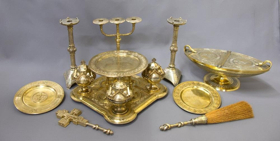Lost Masterpieces of Imperial Romanov Liturgical Silver on View at Museum of Russian Icons

The Museum of Russian Icons will be presenting Opulence Rediscovered: the Romanov Liturgical Silver, the first exhibition in more than 50 years of a lost masterpiece, October 19, 2018 - January 13, 2019. This extraordinary set of Russian Orthodox liturgical implements was made in 1877 as part of the imperial dowry of Grand Duchess Maria Alexandrovna Romanova (1853-1920), the only surviving daughter of Russian Emperor Alexander II, who married Prince Alfred, Duke of Edinburgh, in 1874, and used this opulent silver set in her private chapel in the Clarence House British Royal Residence in London.
Commissioned by the cabinet to the Russian Imperial Court, the Romanov silver set was based on designs by court architect David Grimm (1823 - 1898), one of the creators of the Neo-Byzantine style in Russia. Manufactured by the leading Saint-Petersburg luxury goods purveyor-a firm of Nicholls & Plincke, known as Magazin Anglais-the work was praised by its contemporaries for its subtlety of design and elegance of artistic execution.
A recently completed attribution attests to the set's Russian Imperial and British Royal family provenance, uncovers the rich history of its creation, and reestablishes its historical significance as a preeminent example of Russian Neo-Byzantine style.
The first public showing in over 50 years, the current exhibition coincides with the 200th anniversary of the birth of Emperor Alexander II, the 165thanniversary of the birth of his daughter the Grand Duchess Maria Alexandrovna, and will take place exactly 140 years since the set was installed in London's Clarence House in 1878. After World War II, the set was acquired by American collector Pavel Fekula (1905 - 1982) who had it exhibited in the Orthodox Room at the Interchurch Center in New York in the 1960s. After his death, the set was broken up and sold to private collectors in the United States. This will be the first time the set has been reunited since it was dispersed in the 1960s.
The Romanov silver comprises sacred implements for performing the Orthodox Divine Liturgy-a Litya set (litiinyi pribor), used for the blessing and consecration of bread, wheat, wine and oil; an aspersorium - a vessel for water blessing (vodosviatnaia chasha); an aspergillum - a brush for sprinkling holy water (kropilo); a hand cross for consecrating water (krest dlia vodosviatiia); two altar candlesticks and two eucharistic plates for the Liturgy of Preparations (proskomidiia); and the Prosphora - the bread preparation used in the Divine Liturgy. Several of the objects are used to serve the wine and host during Eucharist, including a chalice, and a discos and asterisk set, on loan from the Holy Transfiguration Monastery in Brookline, MA; as well as a discos and asterisk from the Holy Trinity Monastery in Jordanville, NY. The asterisk is a piece that fits on top of the discos to keep the priest's veil from falling into the host. The pieces are made of a heavy gauge silver of 84 zolotniks Imperial silver purity standard (an equivalent to .875) using techniques of casting, chasing, and engraving.
The rediscovery, reuniting, and exhibition of an almost entirely forgotten set of objects directly connected with the life of Alexander II will undoubtedly enrich our understanding of the ways in which the family life and parental concerns of the Imperial family were inextricably intertwined with the history of Russia and Europe in the second half of the 19th century. It will be an occasion to reassess the significance of Alexander's policies and the impact of the socio-economic reforms he had initiated during his reign.
The exhibition is curated by Dmitry Gurevich and Vladimir Kasykin.
Due to the special significance of this exhibition, his Eminence Metropolitan Hilarion of Eastern America and New York, a bishop of the Russian Orthodox Church, will give remarks at the opening reception of the exhibition on Friday, October 19 from 6:00-8:00pm. Museum members free, nonmembers $15. Register by October 15 by calling 978.598.5000 x121.

Videos
.png)